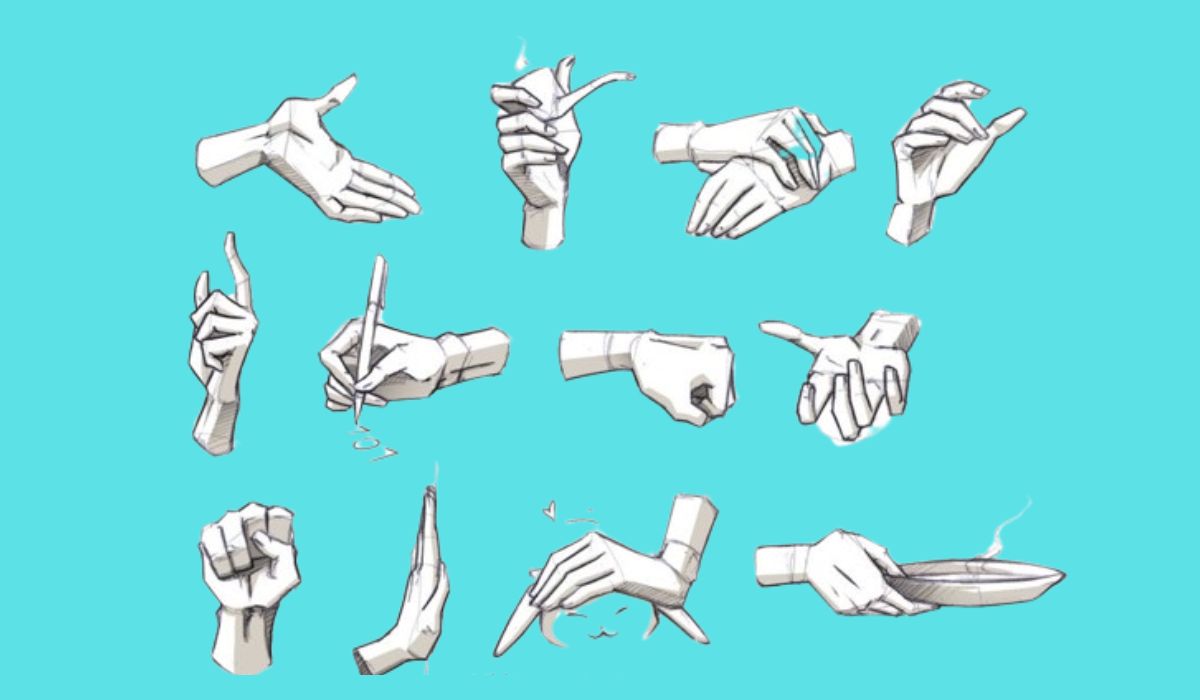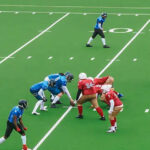Hands. They are one of the most expressive and intricate parts of the human body, capable of conveying a wide range of emotions and gestures. Whether you’re an aspiring artist or a seasoned professional, understanding how to effectively capture this complexity is essential in creating realistic and captivating artwork.
In this comprehensive guide, we will delve into the world of hand reference – a powerful tool that can enhance your artistic skills and take your drawings to new heights. From exploring different poses and gestures to dissecting anatomy and proportion, we’ll unlock the secrets behind mastering hands with confidence.
So grab your sketchbook, sharpen those pencils, and get ready to embark on an enlightening journey into the artistry of hands! Are you ready? Let’s dive right in!
Understanding the Importance of Hand Reference in Art
When it comes to creating truly lifelike and expressive artwork, mastering the art of drawing hands is crucial. Hands have the ability to convey emotions, tell stories, and add depth to your work. They are an integral part of human anatomy and can make or break a composition.
But why is hand reference so important? Well, let’s think about it for a moment. How many times have you struggled with getting the proportions right or capturing that perfect gesture? It’s not uncommon for artists to encounter these challenges when drawing hands from imagination alone.
That’s where hand reference comes in handy (pun intended). By studying real-life hand poses and gestures through photographs or even using your own hands as references, you can gain valuable insights into their structure, movement, and intricate details.
Hand reference serves as a visual aid that helps you understand how each joint connects, how muscles flex and stretch, and how light interacts with different angles. It allows you to observe subtle nuances like wrinkles, veins, or scars that bring authenticity to your drawings.
Additionally, referencing real hands provides an opportunity for improving accuracy in proportion. You can compare measurements between fingers and palm sizes against known references – be it anatomical charts or photographs – ensuring your drawings maintain realistic proportions.
So next time you find yourself struggling with those tricky digits on paper or canvas, remember the importance of hand reference. Embrace this powerful tool as an invaluable asset in honing your artistic skills and bringing life to your creations!
Exploring Different Hand Poses and Gestures
Hands are incredibly expressive, capable of conveying a wide range of emotions and actions. As an artist, understanding the different poses and gestures that hands can take is essential for creating realistic and dynamic artwork.
One of the first steps in exploring hand poses is to observe them in real life or through reference photos. Take note of how the fingers curl or extend, how the palm flexes or flattens, and how the wrist rotates. Each subtle movement contributes to a unique gesture that can tell a story within your artwork.
Experiment with various hand positions to enhance your skills. Start by practicing basic poses such as closed fists, open palms, pointing fingers, and gripping objects. Gradually move on to more complex gestures like thumbs up, peace signs, and even intricate hand movements from dancing or playing musical instruments.
To truly master these poses and gestures, it’s important to study anatomy as well. Understanding the underlying bone structure and muscle groups will help you accurately depict hands in different positions.
Additionally, consider incorporating foreshortening techniques when drawing hands at extreme angles or close-up shots. This will add depth and dimension to your artwork while maintaining anatomical accuracy.
Remember that every person has unique hand characteristics: wrinkles on their skin texture patterns may differ; some people have long slender fingers while others have shorter stubby ones; certain individuals may have distinguishing scars or birthmarks. By paying attention to these details when referencing real-life hands or photographs online can make your art all the more authentic!
By continuously exploring different hand poses and gestures through observation and practice , you’ll gradually develop confidence in capturing their essence within your artwork! So roll up those sleeves (pun intended) grab a pencil,and let your creativity flow!
Techniques for Observing and Studying Hands
When it comes to drawing hands, observation is key. Taking the time to carefully study and understand the intricate details of each finger, joint, and muscle can greatly enhance your ability to capture their essence on paper.
One technique for observing hands is through close-up photography. By taking photos from different angles and perspectives, you can examine the subtle nuances of hand gestures that might be difficult to see with the naked eye alone.
Another effective technique is life drawing sessions. Whether it’s attending a figure drawing class or setting up a still life with your own hand as the subject, these sessions allow you to observe hands in real-time and practice capturing their form accurately.
Additionally, studying anatomical references such as books or online resources can provide valuable insight into how each bone and muscle contributes to the overall structure of the hand. Understanding these underlying structures will help you create more realistic drawings.
Furthermore, don’t underestimate the power of sketching from memory. After studying various hand poses and gestures extensively, test your knowledge by attempting to draw them without direct reference material. This exercise will challenge your understanding of proportions and improve your ability to recreate complex hand movements.
Remember that mastering the art of observing and studying hands takes time and practice. Be patient with yourself as you develop this skill set, knowing that every stroke brings you closer to creating lifelike representations of one of our most expressive body parts – our hands!
Using Hand Reference as a Tool for Improving Anatomy and Proportion
Using hand reference as a tool for improving anatomy and proportion is essential for artists looking to enhance the realism and accuracy of their drawings. The human hand is an intricate structure with complex bones, muscles, and tendons that can be challenging to capture accurately. By studying hand reference photos or using live models, artists can gain a deeper understanding of the intricacies of the hand’s anatomy.
One technique for utilizing hand reference is through careful observation and analysis. Artists should pay attention to the positioning of each finger, noting how they bend at different joints. It’s crucial to observe the placement and length of each digit in relation to one another.
Another aspect of using hand reference effectively is understanding proportion. Hands come in various shapes and sizes, so it’s important for artists to grasp how hands relate to other parts of the body in terms of size and scale. This knowledge enables them to create realistic proportions within their artwork.
Additionally, referencing hands allows artists to examine details such as wrinkles, skin texture, veins, and nail shapes – all contributing factors that add authenticity and depth to their drawings.
By incorporating hand references into their art practice regularly, artists can strengthen their understanding of anatomy while refining their skills in capturing accurate proportions – two vital elements that contribute greatly towards creating lifelike artwork!
Tips and Tricks for Drawing Hands with Confidence
Drawing hands can be a daunting task for many artists, but with the right tips and tricks, you can master this intricate art form and draw hands with confidence. Here are some techniques to help you improve your hand-drawing skills:
1. Start with basic shapes: Begin by sketching simple geometric shapes that represent the palm, fingers, and thumb. This will serve as a foundation for more detailed drawings.
2. Study anatomy: Understanding the underlying structure of the hand is crucial for accurate representation. Take time to study the bones, muscles, tendons, and joints of the hand to make your drawings more realistic.
3. Observe different angles: Hands can take on various poses from different angles. Practice drawing hands in various positions – open palms, clenched fists, pointing fingers – from different perspectives to develop versatility in your artwork.
4. Break it down into parts: Instead of tackling the entire hand at once, break it down into smaller sections like individual fingers or segments of the palm. This allows you to focus on each part separately and achieve better results.
5. Use reference images: Utilize photographs or live models as references when practicing drawing hands. Pay attention to details such as wrinkles, knuckles, nails, and how light falls on them.
6.Trust your instincts: While studying anatomy is important for accuracy, don’t be afraid to let go of strict realism occasionally and trust your artistic intuition. Experiment with stylized or exaggerated forms that still capture essence of a hand’s gesture or expression.
7.Practice regularly: Like any skill in art — practice makes perfect! Dedicate regular sessions solely focused on drawing hands to build muscle memory and improve over time.
Analyzing and Capturing Hand Expressions and Emotions
Analyzing and capturing hand expressions and emotions is a vital aspect of mastering the art of hand reference. Hands have the incredible ability to convey a wide range of emotions, from joy and excitement to sadness or anger. As an artist, being able to accurately depict these subtle nuances can bring depth and realism to your artwork.
To effectively analyze hand expressions, it’s important to pay attention to the positioning and movement of each finger. Notice how they curve or straighten, as well as their relative distance from one another. This will help you capture gestures that communicate different emotions.
Another key element in capturing hand expressions is observing wrinkles, creases, and veins on the hands. These details add texture and authenticity to your drawings. Additionally, studying photographs or live models can provide valuable insights into how different individuals express themselves through their hands.
Experiment with various drawing techniques like shading or cross-hatching to enhance the three-dimensional quality of your hand illustrations. Remember that light plays an essential role in bringing out form and contours.
When portraying emotional states such as tension or relaxation, consider the overall shape of the hand: whether it appears clenched or open-palmed can speak volumes about a person’s state of mind.
Don’t forget about body language! The position of hands in relation to other parts of the body can further emphasize emotions conveyed by facial expressions or postures.
By honing your skills in analyzing and capturing hand expressions and emotions through observation and practice, you’ll be able to create compelling artwork that resonates with viewers on a deeper level.
Incorporating Hand Reference in Various Art Styles and Mediums
Art is a diverse field that encompasses various styles and mediums, each with its own unique challenges. When it comes to incorporating hand reference into different art styles and mediums, there are countless possibilities for exploration and creativity.
Traditional artists working with pencil or paint can use hand reference to enhance the realism of their work. By studying the intricate details of hands – from the shape of each finger to the texture of the skin – artists can bring depth and authenticity to their compositions.
For those exploring digital art, hand reference becomes an invaluable tool. Digital artists can utilize software programs that offer 3D models or poseable mannequins to create accurate hand poses in their artwork. This allows for more flexibility and experimentation when it comes to composition and perspective.
In addition, illustrators who specialize in character design can use hand reference as a means of expressing personality traits through gesture. The way a character’s hands are positioned or how they interact with objects can convey emotions such as confidence, vulnerability, or excitement.
When working with abstract or stylized art forms, referencing hands might seem less necessary at first glance. However, even in these cases, understanding the anatomy and structure of hands is crucial for creating convincing shapes and proportions that harmonize with the overall style.
Mixed media artists have endless opportunities when it comes to incorporating hand reference into their work. They can combine traditional drawing techniques with collage elements featuring real photographs or cutouts of hands. This juxtaposition creates intriguing visual narratives that engage viewers on multiple levels.
No matter what style or medium an artist chooses to explore, incorporating hand reference offers numerous benefits. It adds depth and realism while also allowing for creative expression through gesture and emotion. So whether you’re a traditional painter or a digital illustrator experimenting with new techniques – don’t underestimate the power of mastering the art of hand reference!
Utilizing Digital Tools and Apps for Hand Reference
In today’s digital age, artists have a wide array of tools at their disposal to enhance their artwork. When it comes to hand reference, digital tools and apps can be incredibly helpful in providing artists with a convenient and accessible way to study and capture the intricate details of hands.
One popular app that many artists swear by is Manus H3:Hand Reference for Art. This powerful tool allows users to browse through an extensive library of hand poses and gestures, providing a wealth of inspiration for any artistic project. With its customizable lighting options, adjustable camera angles, and high-resolution images, this app offers artists the opportunity to explore hands from every possible angle.
Another advantage of using digital tools for hand reference is the ability to zoom in on specific areas or rotate the image for a better view. This level of control allows artists to closely examine the anatomy and proportions of hands without limitations.
Digital tools also offer versatility as they can be used alongside traditional art mediums or integrated into digital art workflows seamlessly. Artists can import hand references directly into their preferred drawing software or use them as visual aids when sketching on paper.
The convenience factor cannot be overlooked either. With digital tools and apps readily available on smartphones or tablets, artists can access hand references anytime, anywhere. Whether you’re sitting in your studio or waiting at a coffee shop, you’ll always have instant access to valuable resources that can inspire your creativity.
While there are numerous digital tools available for hand reference purposes, it’s important not to solely rely on them. Traditional observation remains crucial in truly understanding how hands move and interact with objects in real life. However, incorporating these technological advancements into your artistic process can undoubtedly enhance your skills and broaden your creative horizons.
So why not embrace the power of technology? Utilize these digital tools and apps alongside traditional methods to take full advantage of what each has to offer – creating stunning artwork that captures the essence of hands with precision and finesse.
Reviews and Recommendations of Hand Reference Resources
Reviews and recommendations of hand reference resources are invaluable for artists looking to improve their skills in drawing hands. With the abundance of options available, it can be overwhelming to choose the right resources. However, with a little research and guidance, finding the perfect hand reference tools becomes much easier.
One highly recommended resource is Manus, Hand Reference for Art App. This app offers a vast collection of high-quality hand references from various angles and perspectives. It allows artists to study hands in detail, exploring different poses and gestures with ease. The intuitive interface makes navigation simple while providing an immersive experience.
Another popular option is Anatomy360’s Hand Pose Pack. This comprehensive pack includes 10 high-resolution 3D scanned hand models that allow artists to examine hands from every angle imaginable. The detailed textures and realistic lighting make it an excellent resource for understanding anatomy and proportion.
For those who prefer physical reference materials, books like “The Artist’s Guide to Drawing Realistic Hands” by Lee Hammond offer step-by-step tutorials combined with helpful tips on capturing realistic hand gestures and expressions.
Online platforms such as Pinterest or Instagram also provide countless references shared by professional artists or photographers specializing in anatomical studies or character designs involving hands.
Review: Manus Hand Reference for Art App
Are you tired of scouring the internet for hand reference images every time you sit down to draw? Look no further than the Manus H3: Hand Reference app. This innovative tool is a game-changer for artists looking to master the art of drawing hands.
The Manus app provides an extensive library of high-quality hand poses and gestures, making it easy to find the perfect reference for your artwork. Whether you’re working on a realistic portrait or a stylized illustration, this app has got you covered.
What sets Manus apart from other hand reference apps is its user-friendly interface and intuitive navigation. With just a few taps, you can easily browse through different categories of hand poses and zoom in on specific details that catch your eye. It’s like having a virtual model at your fingertips!
One standout feature of the Manus app is its ability to customize hand poses. You have complete control over finger positions, wrist angles, and even lighting conditions. This level of flexibility allows artists to push their creativity and explore different possibilities in their artwork.
Another impressive aspect of this app is its compatibility with digital drawing tools such as tablets and styluses. You can import hand references directly into popular art programs like Photoshop or Procreate, allowing for seamless integration into your workflow.
The Potential of Hand Reference in Art
Hands are powerful tools that can convey a wide range of emotions, actions, and stories. As artists, we know how challenging it can be to capture the complexity and intricacy of hands in our artwork. That’s where hand reference comes in.
By using hand reference, artists unlock a world of possibilities for their art. It allows us to study different hand poses and gestures, understand their anatomy and proportion more accurately, and ultimately create more realistic and dynamic illustrations.
Hand reference serves as a visual guide that helps us observe and study hands from various angles. Whether you’re drawing a relaxed hand gesture or a clenched fist full of tension, having access to different references enables you to grasp the subtleties of each pose.
Moreover, incorporating hand reference into your artistic process not only improves your understanding of hands but also enhances your overall anatomical knowledge. By analyzing the structure and proportions through references, you’ll develop better skills in depicting other parts of the body as well.
Drawing hands confidently requires practice and observation. One helpful tip is breaking down complex poses into basic shapes before adding details. This approach helps ensure accuracy while maintaining fluidity in your drawings.
Additionally, pay attention to capturing expressions with precision – whether it’s conveying joy through an open palm or anguish through tightly clenched fingers. Observe how subtle changes like finger positioning or wrist angle can dramatically alter the mood or story being told by the hand.
No matter what art style or medium you prefer working with – be it realistic pencil sketches or vibrant digital paintings – incorporating hand reference will undoubtedly enhance your work. You can adapt these references to fit any style by studying different techniques used by other artists who specialize in similar styles.
With advancements in technology today, utilizing digital tools for accessing diverse collections of high-quality hand reference images has become easier than ever before! Numerous apps provide vast libraries filled with photos specifically curated for artists’ needs – making it a convenient and valuable resource for artists on-the-go.
Family Sharing: Sharing Hand Reference with Other Artists
One of the most beautiful aspects of art is its ability to bring people together and create a sense of community. As artists, we thrive on inspiration and learning from one another. This is where the concept of family sharing comes into play when it comes to hand reference.
Imagine being able to connect with other artists who share your passion for honing their hand-drawing skills. By sharing hand reference resources, you not only expand your own knowledge but also contribute to the growth and development of fellow artists.
There are various ways in which you can share hand reference with others. You could organize workshops or drawing sessions where artists gather together to study hands from real-life references or photographs. Collaborative projects can be undertaken where different artists contribute their unique interpretations of hands.
The digital age has brought us closer than ever before, making sharing even easier. Online platforms provide spaces for artists worldwide to connect and exchange ideas and resources. Social media groups, forums, and art communities allow us to upload our hand studies, seek feedback, and engage in discussions about techniques or challenges faced during the process.
By actively participating in these communities and engaging in constructive conversations about hand reference, we create an environment that fosters growth not just for ourselves but for everyone involved.
So why should we limit our exploration of hand reference solely within the confines of our studio walls? Let’s step out into this vast world filled with talented individuals eager to learn alongside us! By sharing our knowledge and experiences through family sharing initiatives, we become part of something greater – a network of passionate creators pushing each other towards excellence.
Also Read: Hand Signals: A Comprehensive Guide to Non-Verbal Communication.











